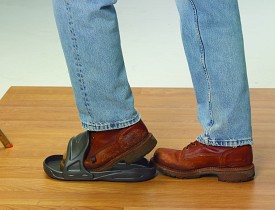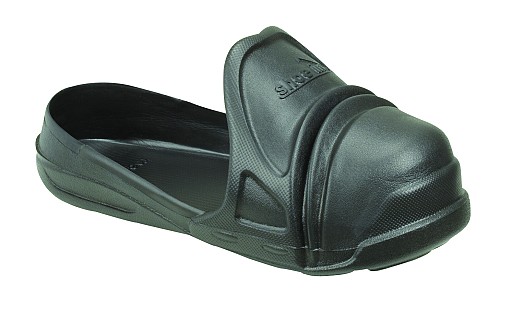Equipment Review: Shoe In Overshoes
 As a pathological DIYer, I do a lot of projects in and around the house, including all of the dirty jobs. I also live in Colorado, where the weather loves to go from blizzard to balmy in the space of a few hours. That means lots of slop. On any project, I like to be as efficient as possible, which often doesn't leave time for removing muddy boots for quick trips into the house. The secret is to pretend I'm not getting the floors dirty by walking very slowly and taking as few steps as possible. This, of course, offers no real benefit whatsoever. Neither does walking on my tiptoes, which just flexes the boot soles, ejecting dirt clods from the waffle crevices, but I try it anyway. (My wife seems to think "efficient" is synonymous with "lazy", but she just doesn't get it.) All of this makes me an excellent candidate to test-drive these new overshoes called Shoe In.
As a pathological DIYer, I do a lot of projects in and around the house, including all of the dirty jobs. I also live in Colorado, where the weather loves to go from blizzard to balmy in the space of a few hours. That means lots of slop. On any project, I like to be as efficient as possible, which often doesn't leave time for removing muddy boots for quick trips into the house. The secret is to pretend I'm not getting the floors dirty by walking very slowly and taking as few steps as possible. This, of course, offers no real benefit whatsoever. Neither does walking on my tiptoes, which just flexes the boot soles, ejecting dirt clods from the waffle crevices, but I try it anyway. (My wife seems to think "efficient" is synonymous with "lazy", but she just doesn't get it.) All of this makes me an excellent candidate to test-drive these new overshoes called Shoe In.
What Are Shoe In Overshoes?
They're essentially oversize plastic slippers that you step into before heading into the house with your work boots on, effectively keeping mud, slush, driveway salt, fertilizer, dog poop, and anything else you've been tromping through off of your cream-colored carpet—or from scratching your hardwood floors. The main difference between Shoe In overshoes and other boot covers is that Shoe In overshoes, made by Weinbrenner USA, are hands-free; you can slip into them and pull them off with your feet alone.
Look and Material
Hip and attractive Shoe In overshoes are not (Frankenstein would consider them "practical"). But they're far less ridiculous-looking than those fabric-and-elastic booties that resemble surgical caps. And Shoe In overshoes are actually shoes; you don't throw them away like the fabric booties. Shoe In overshoes are made of EVA plastic. It's similar to the material Crocs are made of, but a little stiffer. The all-plastic construction makes them completely washable and waterproof. When your Shoe In overshoes get dirty you just hose them off and let them drip-dry.

Design Features
The most clever elements of the Shoe In design are the two rows of "fingers" that extend straight down from the instep. The fingers are flexible, allowing your boot to slide in, then they grab onto it to keep it from slipping out. The fingers also are the secret to accommodating a variety of boot and shoe sizes, thanks to their flexibility. My Shoe In overshoes even stay on without shoes, at well least enough for a casual trip to the mailbox.
This brings up another important advantage Shoe In overshoes have over surgical-cap booties and conventional overshoes: Shoe In overshoes are equally useful for indoor and outdoor travel. For example, during the growing season, you can keep a pair of Shoe In overshoes at your back door to protect your floors from muddy gardening boots. In the winter or rainy season, you can park them outside your front door or in the mudroom and use them for stepping out to grab the morning paper without having to take off your slippers. Shoe-Ins have a gently waffled sole with a textured surface for slip-resistance.
Options
The Shoe In overshoes I tested are the "closed-toe" models. Standard Shoe In overshoes are open-toed but have the same basic design with the fingers in the instep and the slip-resistant sole. I've also found an "outdoor" model online, which apparently features metal cleats for added slip-resistance. The only disadvantage I can imagine with the outdoor version is that it might not be suitable for indoor use on some types of flooring.
Final Review
In short, I found the Shoe In overshoes to be a pretty darned elegant solution to an everyday inconvenience, and I'm quite happy that I get to keep my samples. As a semi-professional Denver-area handyman, I've already put them to the test with mud-caked boots going indoors and nice, dry socks going outdoors. This winter, I'll keep them at my back door for trips inside with armloads of firewood. And my wife is a gardener, so I suspect the Shoe In overshoes will become his/her items next spring. (Romantic, I know. Just like Bride of Frankenstein.)
Philip Schmidt writes for Networx.com.
Looking for a Pro? Call us (866) 441-6648

Landscaping Average Costs
Landscapers Experiences

Concrete Slab Installation For My Travel Trailer

My Son’s Stamped Concrete Patio Was A Fast Track, Quality Job



